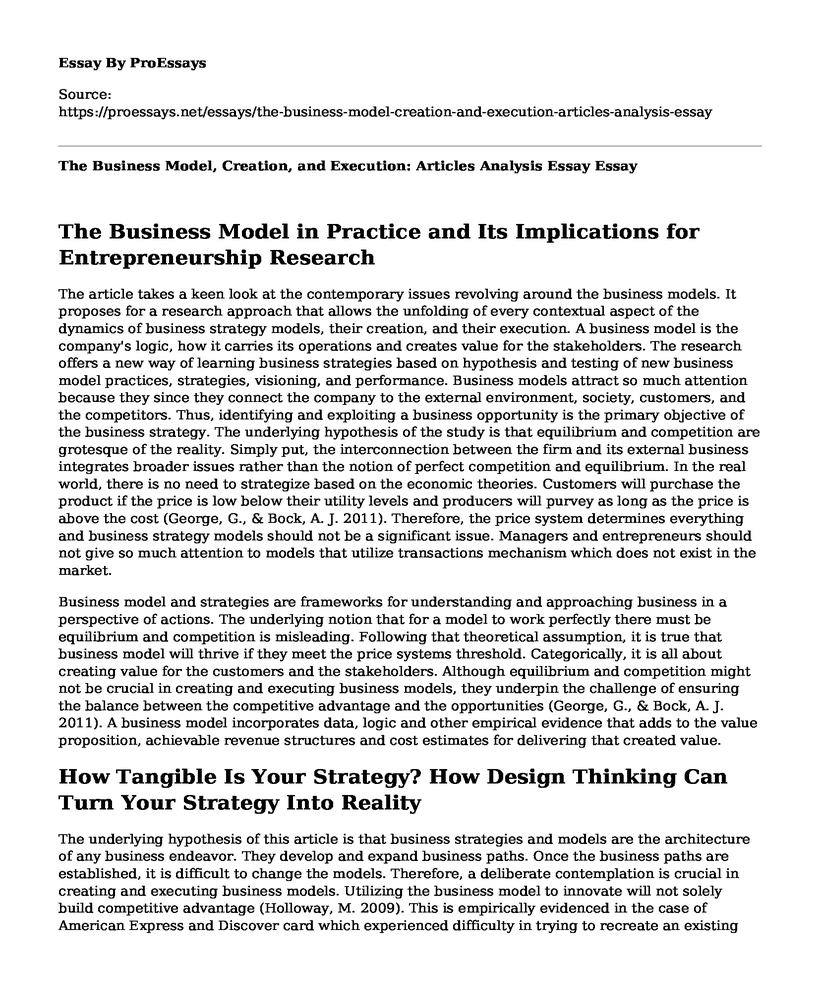The Business Model in Practice and Its Implications for Entrepreneurship Research
The article takes a keen look at the contemporary issues revolving around the business models. It proposes for a research approach that allows the unfolding of every contextual aspect of the dynamics of business strategy models, their creation, and their execution. A business model is the company's logic, how it carries its operations and creates value for the stakeholders. The research offers a new way of learning business strategies based on hypothesis and testing of new business model practices, strategies, visioning, and performance. Business models attract so much attention because they since they connect the company to the external environment, society, customers, and the competitors. Thus, identifying and exploiting a business opportunity is the primary objective of the business strategy. The underlying hypothesis of the study is that equilibrium and competition are grotesque of the reality. Simply put, the interconnection between the firm and its external business integrates broader issues rather than the notion of perfect competition and equilibrium. In the real world, there is no need to strategize based on the economic theories. Customers will purchase the product if the price is low below their utility levels and producers will purvey as long as the price is above the cost (George, G., & Bock, A. J. 2011). Therefore, the price system determines everything and business strategy models should not be a significant issue. Managers and entrepreneurs should not give so much attention to models that utilize transactions mechanism which does not exist in the market.
Business model and strategies are frameworks for understanding and approaching business in a perspective of actions. The underlying notion that for a model to work perfectly there must be equilibrium and competition is misleading. Following that theoretical assumption, it is true that business model will thrive if they meet the price systems threshold. Categorically, it is all about creating value for the customers and the stakeholders. Although equilibrium and competition might not be crucial in creating and executing business models, they underpin the challenge of ensuring the balance between the competitive advantage and the opportunities (George, G., & Bock, A. J. 2011). A business model incorporates data, logic and other empirical evidence that adds to the value proposition, achievable revenue structures and cost estimates for delivering that created value.
How Tangible Is Your Strategy? How Design Thinking Can Turn Your Strategy Into Reality
The underlying hypothesis of this article is that business strategies and models are the architecture of any business endeavor. They develop and expand business paths. Once the business paths are established, it is difficult to change the models. Therefore, a deliberate contemplation is crucial in creating and executing business models. Utilizing the business model to innovate will not solely build competitive advantage (Holloway, M. 2009). This is empirically evidenced in the case of American Express and Discover card which experienced difficulty in trying to recreate an existing model while building new market expansions. Creating new business models or rebuilding the existing ones often results in increased customer value or reduced costs. If the model cannot be easily be replicated by the rivals, it is easy to generate significant returns.
In the business realm, it is imperative for the managers to business models, assets, value propositions and processes that are hard to replicate. Taking, for instance, big successful companies like the Google, Amazon, Apple among others. These companies have created business models in their portfolios which are almost impossible to replicate since they require a big deal of time and resources. When gateway computers tried to implement Dell's model on direct-to-user, they failed despite the model being so easy (Holloway, M. 2009). Dell's performance caused their failure; therefore, the value proposition is crucial when building a business model. Additionally, managers should integrate into their models some attributes of opacity. That is uncertain imitation which makes it hard for the competitors to understand how the implementation of the model is done or how the aspects of the model create customer acceptability.
Conclusion
In conclusion, business model and strategy is a challenging endeavor, and it requires seasoned executive with high emotion and intelligent quotients to facilitate and enable appropriate business model and pioneer the execution (Zott, C., Amit, R., & Massa, L. 2011). Business models define the direction and success of the firm, therefore having the proper model will require massive resources like extinguished leaders, time and money.
References
George, G., & Bock, A. J. (2011). The business model in practice and its implications for entrepreneurship research. Entrepreneurship theory and practice, 35(1), 83-111.
Holloway, M. (2009). How tangible is your strategy? How design thinking can turn your strategy into reality. Journal of Business Strategy, 30(2/3), 50-56.
Woerner, S. L., & Wixom, B. H. (2015). Big data: extending the business strategy toolbox. Journal of Information Technology, 30(1), 60-62.
Zott, C., Amit, R., & Massa, L. (2011). The business model: recent developments and future research. Journal of management, 37(4), 1019-1042.
Cite this page
The Business Model, Creation, and Execution: Articles Analysis Essay. (2022, Apr 11). Retrieved from https://proessays.net/essays/the-business-model-creation-and-execution-articles-analysis-essay
If you are the original author of this essay and no longer wish to have it published on the ProEssays website, please click below to request its removal:
- Challenges in the Global Business
- Essay Sample on Green Clean Contract Risks and Liabilities
- Essay on Challenges Ahead for Kingston Family Vineyards in Chilean Wine Industry
- Paper Example on Eileen's Frustration With Geoffrey's Arrogance in Interpersonal Relations Workshop
- Essay Example on Globalization Boosts Business in Hospitality Industry: Managerial Insights
- Paper Example on Abyrs Food: Delivering Delicious Roast Beef Since 1964
- Essay Example on Corporate Law: How Corporations Gain Power with the Law







